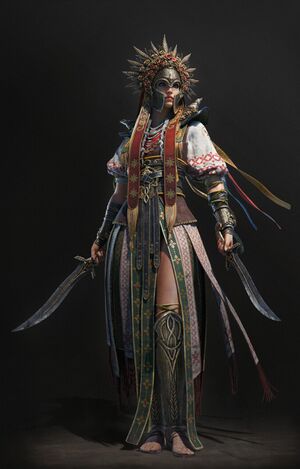Septimia Sulunia
This article is incomplete because it is pending further input from participants, or it is a work-in-progress by one author. Please comment on this article's talk page to share your input, comments and questions. Note: To contribute to this article, you may need to seek help from the author(s) of this page. |
Septimia Sulunia | |
|---|---|
 An artistic depiction of Septimia based on contemporary written accounts. | |
| Born | c. 191 CE Cesena, Sarassita, Sabrian Empire |
| Died | c. 226 CE (aged 34 – 35) Vichenza, Sarassita, Sabrian Empire |
| Resting place | Great Temple of Septimia of Orange, Cesena |
| Occupation | Heirodule, Warrior Priestess |
| Organization | Cult of Transformation Order of Septimia |
| Known for | Septimian Rebellion |
| Office | High Confessor of the Septimians (213 CE – 226 CE) |
| Opponent(s) | Legate Aulza Plaute |
| Children | Thiphilia Sulunia Caia Sulunia |
| Military career | |
| Allegiance | Septimians |
| Years of service | 213 CE – 226 CE |
| Rank | High Confessor |
| Conflicts | Septimian War |
Septimia Sulunia (c. 191 CE – c. 226 CE), often referred to by her followers as Septimia the White, was a Cacertian hierodule and eventual warrior priestess who instigated the Septimian Rebellion against the rule of Legate Aulza Plaute. Septimia is considered by many to be a defender of the common people and she is greatly regarded in modern-day Cacerta as a popular symbol and a martyr of democracy.
By the late 100s CE, the role of Legatus had become an effective monarchical dictatorship with succession determined by appointment of the currently ruling Legate. The Sabrian Senate no longer voted for the Legate and although confirmation by the Senate was still conducted, confirmation ceremonies were strictly a formality and no longer had any political weight. Power over the Empire was shared between the Legate and the Legate Council which was founded in the aftermath of the Second Acro-Sabrian War.
Preaching the need for political change within Sabria , Septimia rose to prominence during this time as a Heirodule of the Cult of Transformation dedicated to the Order of Septimia in Cesena. Her sermons and rituals quickly gained traction with the disenfranchised common populace; despite threats from the capital and Legate Aulza Plaute, Septimia continued to preach. The Legate’s attempt to arrest Septimia in the fall of 212 CE was stopped by a large crowd of Septimia’s followers and the riot that ensued is generally regarded as the start of the Septimian Rebellion.
Septimia led an armed resistance against the government of Sabria for nearly thirteen years before being captured in an ambush of her personal guard in 225 CE. Calls to release Septimia by the people on both sides of the conflict as well as many members of the Sabrian Senate were not fulfilled and after being branded a heretic by Plaute, Septimia was executed in 226 CE and buried in an unmarked grave outside of Vichenza. Despite her death, the Septimians hailed her a martyr for the cause of the Cult of Transformation and the rebellion continued for another decade. The Septimians successful overthrew the government in 236 CE and restored the old order of the Sabrian Senate and the necessity for the election of the role of the Legate.
After the conflict ended, Septimia’s body was recovered and she was buried at the Great Temple of Septimia of Orange, the location where her rebellion began.